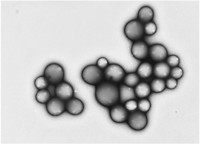Advertisement
Grab your lab coat. Let's get started
Welcome!
Welcome!
Create an account below to get 6 C&EN articles per month, receive newsletters and more - all free.
It seems this is your first time logging in online. Please enter the following information to continue.
As an ACS member you automatically get access to this site. All we need is few more details to create your reading experience.
Not you? Sign in with a different account.
Not you? Sign in with a different account.
ERROR 1
ERROR 1
ERROR 2
ERROR 2
ERROR 2
ERROR 2
ERROR 2
Password and Confirm password must match.
If you have an ACS member number, please enter it here so we can link this account to your membership. (optional)
ERROR 2
ACS values your privacy. By submitting your information, you are gaining access to C&EN and subscribing to our weekly newsletter. We use the information you provide to make your reading experience better, and we will never sell your data to third party members.
Biochemistry
Artificial melanin gets into the skin
Polydopamine nanoparticles could protect skin cells from DNA damage caused by ultraviolet radiation
by Wudan Yan
May 24, 2017

Melanin is the pigment responsible for human skin and hair color—and it helps protect skin cells from sun damage by absorbing ultraviolet rays and scavenging free radicals. Attempting to reproduce these properties, researchers have demonstrated that nanoparticles made with artificial melanin can protect cultured skin cells from UV radiation (ACS Cent. Sci. 2017, DOI: 10.1021/acscentsci.6b00230). The research serves as an important first step in developing new treatments for people with medical conditions related to melanin deficiency, such as albinism and vitiligo, which can increase the risk for skin cancer, the researchers say.

In the skin, melanin—derived from the amino acid L-DOPA, the precursor to dopamine—is made by specialized cells called melanocytes and packaged in small vesicles called melanosomes. These melanosomes are then taken up by adjacent keratinocytes—the predominant type of skin cell. The melanosomes surround the keratinocyte nuclei, forming a shield that protects DNA from UV radiation.
Researchers have known for years that polymers of dopamine act in many situations as an artificial form of melanin. Both molecules have a structurally similar interconnected system of aromatic rings. Nathan C. Gianneschi, a chemist and materials scientist at the University of California, San Diego, had been working on developing polydopamine nanoparticles for other applications, and recently began to wonder if he could use the same particles, made from dopamine derivatives, to reproduce the effects of melanin in skin cells. The key was to use the polydopamine particles “to mimic naturally occurring melanosomes and see if the keratinocytes can take these particles up,” Gianneschi says.
The scientists incubated keratinocytes with polydopamine nanoparticles and saw from microscopy experiments that the nanoparticles packed around the nuclei of the cells in patterns consistent with those of natural melanosomes. “We had no idea if these nanoparticles would behave similarly to natural melanin, so the fact that they were broken down and smeared around the nucleus was a pleasant surprise,” Gianneschi says. Moreover, when the cells were exposed to UV light, keratinocytes with the artificial melanin were 40% more viable than cells without. Cells with the nanoparticles were also able to suppress the production of reactive oxygen species, a by-product of cellular stress following UV damage.
Researchers, including Matthew D. Shawkey, an integrative biologist at Ghent University who was not involved in the study, have used polydopamine particles to make colored films. But, Shawkey says, this work shows they have other uses: “These particles seem to be quite biocompatible and hold great promise for biomedical applications.”
Although these early results are promising, translating these findings into therapeutic drugs or sunblocking cosmetics faces significant barriers, says Gianneschi. “Melanin is a really enigmatic material that we’re excited about for many different applications. While it has this intrinsic function in skin cells, synthetic forms of it could work for pigment replacement in other tissues,” he says, such as in the eye, where a lack of melanin can cause poor daytime vision.




Join the conversation
Contact the reporter
Submit a Letter to the Editor for publication
Engage with us on Twitter